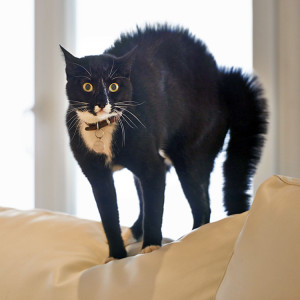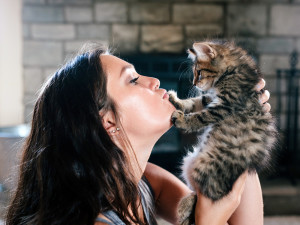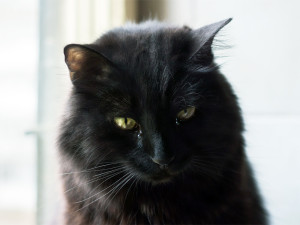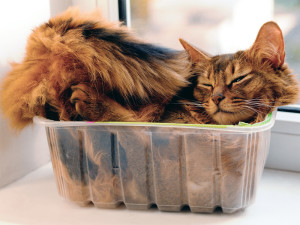Is Cat Paw Reading Real? The Internet Thinks Your Kitty's “Toe Beans” Can Reveal Their Personality
Could the secret to understanding your cat be right under their paws?

share article
Your cat is a mystery. A puzzle. A spicy little enigmaopens in a new tab wrapped in fur. It’s part of their appeal. Part of what makes them so amusing. And yet, wouldn’t it be nice to have a few more insights into who they are and why they do the things they do? Even if those insights weren’t exactly scientific?
Enter pawmistry: the divine art of cat paw reading. You’ve heard of palmistry, right? Where a skilled practitioner (or a swindler, depending on how you look at things) reads the lines on the palm of your hand to determine your future? It’s an ancient art designed to separate gullible people from their money. And if you believe in that, then you might as well believe in this. And if you don’t believe in any of it, well, keep reading anyway, because it’s fun.
What to understand about cat paws
But first, a little about the paw itself. Cats (like dogs, kangaroos, and rodents) are digitigrade animals, which means they walk on their toes, with their heels raised off the ground. Like humans, cats often have a dominant paw: a front paw they favor when reaching for things or covering their business in the litter box. This is the paw you “read” when practicing pawmistry. Don’t try reading the other paw, because that paw lies. And you don’t want that. Because you value the truth. No matter how made up it is.
A typical front paw has seven soft, fleshy, hairless pads, which we will heretofore call “beans.” There is the metacarpal bean, that’s the big one in the middle (so squishy!); the four digital beans, which are equivalent to human fingers; the dewclaw bean, only present on the front paws and similar to the human thumb; and, finally, the carpal bean, a clawless bean located a little further up the leg that provides traction when coming to a stop or descending a slope.
Cat-paw readers (yes, it’s a thing)
A lot of the information on pawmistry circling on the internet right now concerns itself specifically with the reading of the metacarpal bean. Many of these articles reference, or presume to reference, a book by a Japanese fortune teller opens in a new tabwho goes by the name of Mr. Akatsuki.
According to this fortune teller, there are five main personality typesopens in a new tab as determined/reflected by the shape of the metacarpal bean. Cats with heart-shaped metacarpal beans are cuddlebugs. Cats with rounded beans are adventurous and social. Flat-topped beans mean a cat is more demure and solitary, while a slight divot in the metacarpal bean means they are downright aloof. And, finally, a pointy bean means your cat is a little, uh, whacky.
Of course, other “resources” break down metacarpal bean shape/meaning differently. This guideopens in a new tab, for instance, which claims (with zero evidence) to be 99 percent accurate, has six categories, as opposed to five, and this TikTokopens in a new tab explaining the guide has over four million views.
The TikToker in the video, @mikiraiofficial, claims the guide is based on the findings of Japanese researchers who examined over 2,000 cats. Of course, she doesn’t include the names of these researchers or any sort of citation of their work and we also could not find it, but that’s probably just because they don’t actually exist and no real scientific research was ever done. But that’s OK, because we are living in a post-truth world, and this is all just for funsies anyway.
Another cat-palm guru, Megan Lynn Kott, actually wrote an entire book on the mystical art of cat decoding. It’s called Pawmistry: Unlocking the Secrets of the Universe with Catsopens in a new tab, and it’s pretty fun, even if it is complete and utter bollox. In it, she devotes an entire chapter to reading your cat’s paws that goes far beyond mere metacarpal-bean analysis.
According to Kott, left-paw-dominant cats tend to be more emotional and are easily distressed, while right-paw-dominant cats are more relaxed and affectionate. Cats with freckled toe beans are supposedly more creative, while black-toe-bean cats are more mystical and were probably a witch’s familiar in a past life. Pink toe beans mean your cat is an egotistical hedonist, and brown toe beans mean your cat is down to earth, you know, because dirt is brown. And gray toe beans signify wisdom, which is a nicer way of saying your cat is old.
Even claw shape has its own special significance, per Kott. Long-claw cats are lazy, while short claw cats are fastidious, and cats without claws are “unlucky in love and friendship” (you can say that again).
Links between cat anatomy and personality (is it a thing)?
Of course, none of these analyses are based on any sort of scientific research, but, hey, even a stopped clock is right twice a day, right? Maybe these preachers of the paw actually stumbled across some real truths purely by accident? “I don’t think so,” says Marci Koskopens in a new tab i, certified feline behavior and training consultant at Feline Behavior Solutionsopens in a new tab. “The purpose of the pads on a cat’s paw is to provide traction and protection while they walk around. They also contain scent glands for marking their territory. The idea that they have anything to do with their personalities is pretty out there.”
Well that’s no fun! What about other physical traits? “I don’t think there are any links whatsoever between anatomy and personality,” Koski adds. “A lot of people think a cat’s fur color has something to do with their personalityopens in a new tab — like that tortoiseshell cats have ‘tortitude’ or that all orange catsopens in a new tab share one common brain cell — but I think it really just comes down to each individual cat.”
Still, if you want to believe in pawmistry, go right ahead. Sure, history is full of pseudosciences, like phrenologyopens in a new tab, that erroneously link anatomical and behavioral differences, often in an attempt to justify racism and other pre-existing prejudices, but this is just for fun. You won’t love your cat any less if you find out they have the pointy pink metacarpal toe beans of a clinically diagnosed narcissist.
References:

Charles Manning
Charles Manning is an actor, writer, and fashion/media consultant living in New York City with his two cats, Pumpkin and Bear. Follow him on Instagram @charlesemanningopens in a new tab.
Related articles
![Woman trying to hug a grumpy orange cat.]() opens in a new tab
opens in a new tabPeople Are Bad at Knowing When Their Cats Are Pissed, New Study Says
We can tell when cats are happy, but we’re pretty bad at figuring out when they’re not.
![Woman holding brown kitten to her face.]() opens in a new tab
opens in a new tab8 Myths About Your Kitten—Busted By a Behaviorist
Forget everything you think you know about baby cats.
- opens in a new tab
Can Cats Sense Pregnancy?
There could be a reason they seem to be a little more obsessed with you than usual.
![cat staring at person on table]() opens in a new tab
opens in a new tabWhy Does My Cat Stare at Me?
...Is it something you said?
- opens in a new tab
Can Cats Cry? How to Decipher Cat Crying
They aren’t exactly going to weep over a rom-com marathon with you, but here are the reasons your kitty could shed a tear.
- opens in a new tab
The Internet Thinks Cats Are Liquid—Here’s Why They Really Can Squeeze Into That Vase
“A cat can generally fit into anything their head can fit into.”







